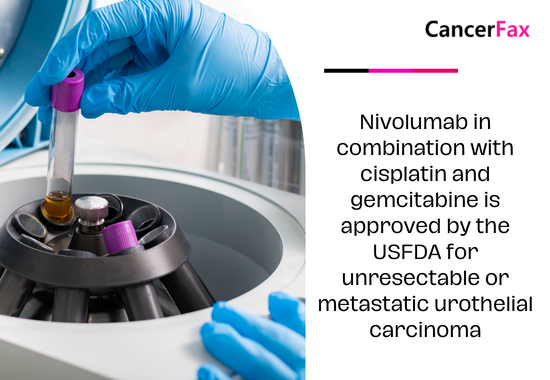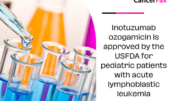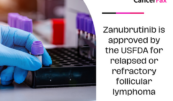Nivolumab in combination with cisplatin and gemcitabine is approved by the USFDA for unresectable or metastatic urothelial carcinoma
March 2024: The Food and Drug Administration has granted approval for the use of nivolumab (Opdivo, Bristol-Myers Squibb Company) in conjunction with cisplatin and gemcitabine as the initial treatment for adult patients with unresectable or metastatic urothelial carcinoma (UC).
The efficacy of the treatment was assessed in a clinical experiment called CHECKMATE-901 (NCT03036098). This trial enrolled 608 patients with advanced urinary bladder cancer that could not be removed by surgery or had spread to other parts of the body. Participants were randomly assigned in a 1:1 ratio to receive either a combination of nivolumab, cisplatin, and gemcitabine (for a maximum of 6 cycles), followed by nivolumab alone for up to two years, or cisplatin and gemcitabine (for a maximum of 6 cycles). Patients who stopped using cisplatin were allowed to start taking carboplatin on both arms. The randomization process was divided into groups based on the expression of PD-L1 in the tumor and the existence of liver metastases.
The primary measures of effectiveness were overall survival (OS) and progression-free survival (PFS), evaluated by an impartial central review using RECIST v1.1.
The combination of nivolumab with cisplatin and gemcitabine, followed by nivolumab alone, showed statistically significant improvements in both overall survival (OS) and progression-free survival (PFS) compared to treatment with cisplatin and gemcitabine alone. The median overall survival (OS) was 21.7 months (95% confidence interval [CI]: 18.6, 26.4) for patients who got the combination of nivolumab, cisplatin, and gemcitabine. In contrast, the median OS was 18.9 months (95% CI: 14.7, 22.4) for those who received only cisplatin and gemcitabine. The hazard ratio (HR) comparing the two groups was 0.78 (95% CI: 0.63, 0.96), indicating a lower risk of death in the nivolumab combination group. The two-sided p-value was 0.0171, suggesting a statistically significant difference between the two treatment groups. The median progression-free survival (PFS) was 7.9 months (95% confidence interval [CI]: 7.6, 9.5) and 7.6 months (95% CI: 6.0, 7.8), respectively. The hazard ratio (HR) was 0.72 (95% CI: 0.59, 0.88), with a two-sided p-value of 0.0012.
The predominant side effects (≥15%) observed in patients treated with nivolumab in combination with platinum-doublet chemotherapy included nausea, fatigue, musculoskeletal discomfort, constipation, decreased appetite, rash, vomiting, peripheral neuropathy, urinary tract infection, diarrhea, edema, hypothyroidism, and pruritis.
Susan Hau is a distinguished researcher in the field of cancer cell therapy, with a particular focus on T cell-based approaches and cancer vaccines. Her work spans several innovative treatment modalities, including CAR T-cell therapy, TIL (Tumor-Infiltrating Lymphocyte) therapy, and NK (Natural Killer) cell therapy.
Hau's expertise lies in cancer cell biology, where she has made significant contributions to understanding the complex interactions between immune cells and tumors.
Her research aims to enhance the efficacy of immunotherapies by manipulating the tumor microenvironment and exploring novel ways to activate and direct immune responses against cancer cells.
Throughout her career, Hau has collaborated with leading professors and researchers in the field of cancer treatment, both in the United States and China.
These international experiences have broadened her perspective and contributed to her innovative approach to cancer therapy development.
Hau's work is particularly focused on addressing the challenges of treating advanced and metastatic cancers. She has been involved in clinical trials evaluating the safety and efficacy of various immunotherapy approaches, including the promising Gamma Delta T cell therapy.
- Comments Closed
- April 6th, 2024






FDA-approved regimen 2024, First-line bladder cancer therapy, Metastatic UC treatment, Nivolumab combination approval, Opdivo for bladder cancer, PD-1 inhibitor combinations, Platinum-based immunotherapy, Unresectable urothelial carcinoma
CancerFax is the most trusted online platform dedicated to connecting individuals facing advanced-stage cancer with groundbreaking cell therapies.
Send your medical reports and get a free analysis.
🌟 Join us in the fight against cancer! 🌟
Привет,
CancerFax — это самая надежная онлайн-платформа, призванная предоставить людям, столкнувшимся с раком на поздних стадиях, доступ к революционным клеточным методам лечения.
Отправьте свои медицинские заключения и получите бесплатный анализ.
🌟 Присоединяйтесь к нам в борьбе с раком! 🌟